“The first 90 minutes are the most important”. Those were the words of the late Sir Bobby Robson, but if only football was that simple. Goals change games, whether they set the tone of the match early doors or make for a dramatic ending.
You didn’t have to be a Manchester City fan to appreciate the enormity of Sergio Aguero’s last-minute winner in 2012 to clinch City’s first Premier League title from bitter rivals Manchester United. Nor did you have to be a Carlisle United fan when their goalkeeper, Jimmy Glass, scored the winner in the final game of the 1998-99 season, in the dying moments, to ensure the Cumbrian’s survival.
Goals dictate the narrative of football and are even more precious in England’s fourth tier. They can be the difference between survival or relegation to the footballing abyss. There have been a total of 714 goals so far in this season’s EFL League Two. But when have these goals been scored, and what can this tell us about certain teams?
This data analysis will provide a breakdown of when goals have been scored in League Two this season with the help of data and statistics. Our analysis will determine when most goals are scored to determine if any patterns exist and see if their approach to games influences when they are scoring goals.
Fewer goals in the opening stages
In the opening 15 minutes of League Two matches this campaign, the fewest amount of goals have been scored.
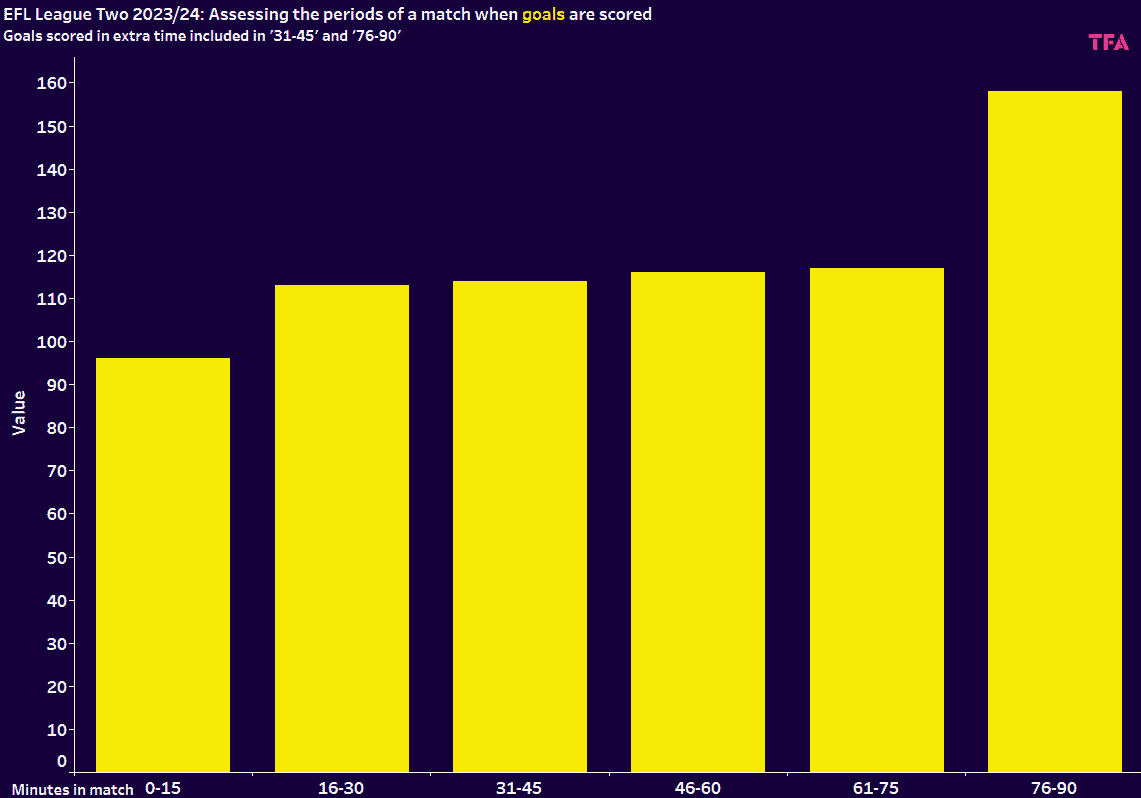
The graph shows that in the opening 15 minutes, 96 goals have been scored. This accounts for 13.4% of total goals in the fourth tier this season. In contrast, 158 goals have been scored in the final 15 minutes of games, 22.1% of total goals scored.
Harrogate Town are the only side in the division not to have scored in this opening period, and they have only conceded three goals during the opening stages. Such statistics ensure that the Sulphurites matches have comprised the fewest amount of goals of all clubs in the opening exchanges.
Such a low amount of goals epitomises their season as a whole, as only Gillingham has scored fewer this season. Harrogate has the lowest expected goal value in open play at 12.78; only three teams in the league have a lower expected goal-against value in open play. Harrogate’s standing at 15.70 expected goals against in open play.
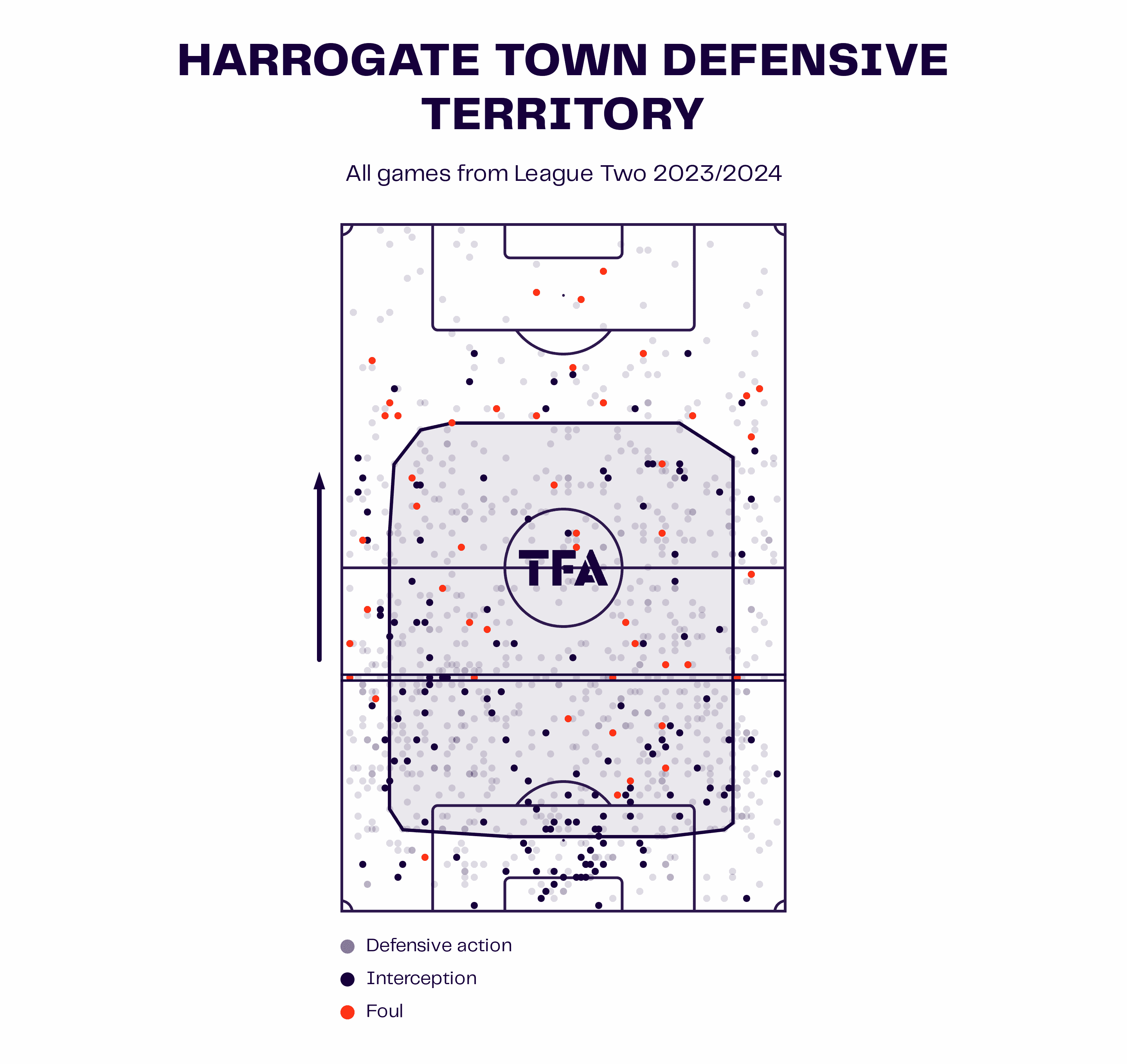
The graphic shows the solid foundations of the Harrogate defence as they are particularly strong at intercepting the play in their defensive third. Only five teams have conceded fewer in the campaign than the North Yorkshire side.
On the other hand, Newport’s matches have featured 12 goals in the opening 15 minutes – scored and conceded – which is the most of any club. Unfortunately for the South Wales side, they have conceded seven goals in the opening stages. Only Walsall have conceded more with eight.
In the seven games where Newport have conceded in the opening 15 minutes, they have only gone on to win one and draw one, losing the rest. This implies how Newport are regularly playing catch-up in matches, and ultimately falling short.
Only six sides in League Two have scored more than five goals in the opening 15 minutes of games. Joint top of the list are MK Dons and Stockport, both with eight goals.
However, for MK Dons, half of these eight early goals came at the beginning of the campaign in August. This coincided with a good run of form for the Dons when they won four of their opening five games. Despite a positive start, MK Dons then went on a nine-game winless streak and only scored two early goals during this miserable spell.
In the seven matches that MK Dons scored in the opening 15 minutes, they went on to win five, draw one, and lose one. This suggests that if the Dons can take hold of a game early, the result tends to go in their favour.
In contrast, league leaders Stockport had a poor start to the season, losing three of the opening five matches. However, since the start of September, they went on a 13-match unbeaten run, including 12 wins on the bounce.
During the 13 matches undefeated, Stockport scored seven of their eight early goals. Moreover, as County hit a rich vein of form, they tended to score goals in quick succession.
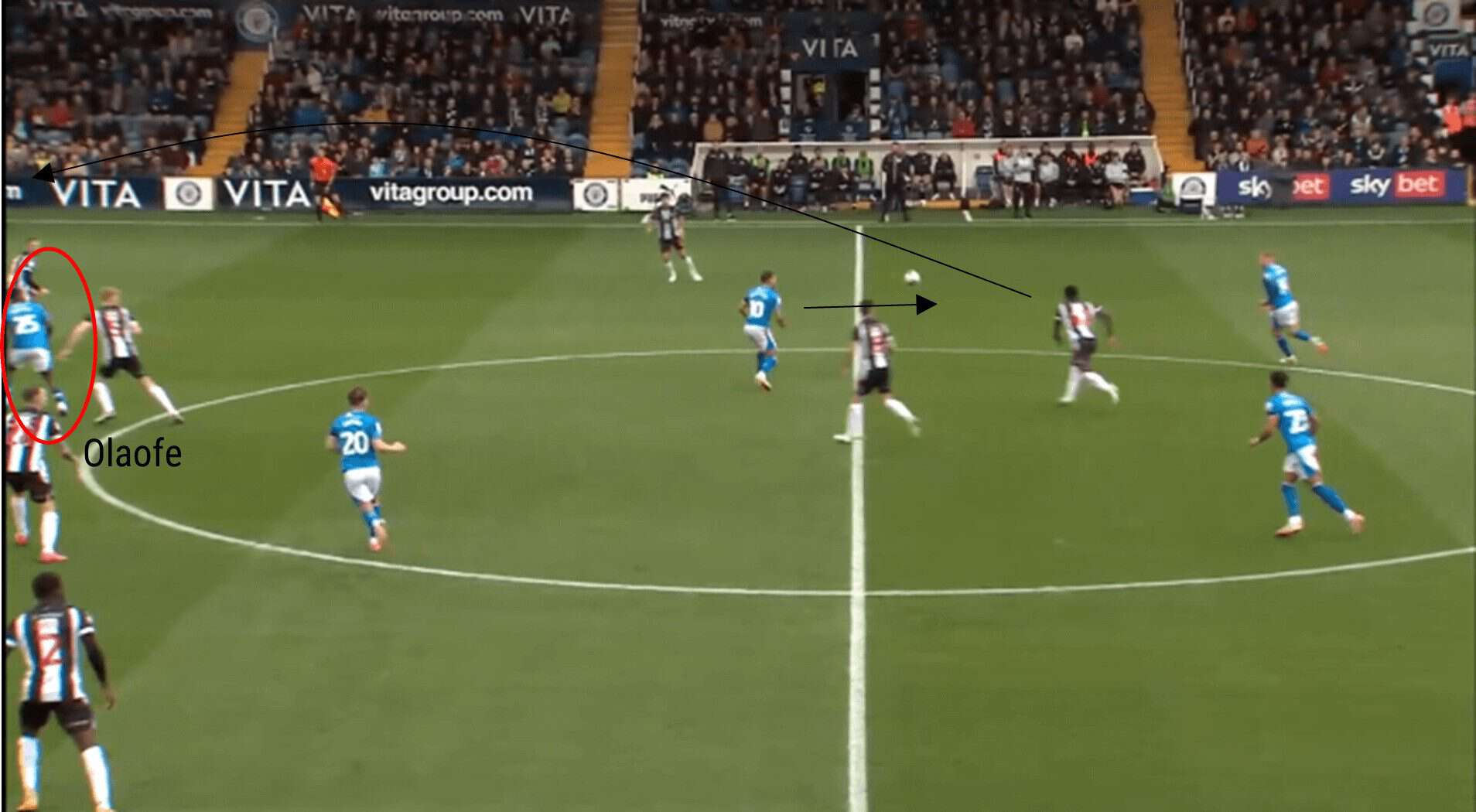
With Stockport having just taken a one-nil lead, the ball is chested down, and instinctively, the ball is played forward, with Isaac Olaofe beating the offside trap to double their lead.
Stockport are a side comfortable in possession, averaging 56.1% of the play, but they are a side that instinctively looks to play forward and utilise the width of the pitch in their preferred 3-5-2 formation. The average amount of time between Stockport goals is 23 minutes; they have gone on to extend their lead within less than five minutes on four occasions.
Such statistics indicate Stockport’s ability to pile the pressure on the opposition in matches. However, Stockport ended matches equally as strong, scoring eight goals in the final 15 minutes.
Late goals aplenty
As the initial bar chart implies, more goals have been scored in the second half of League Two matches.
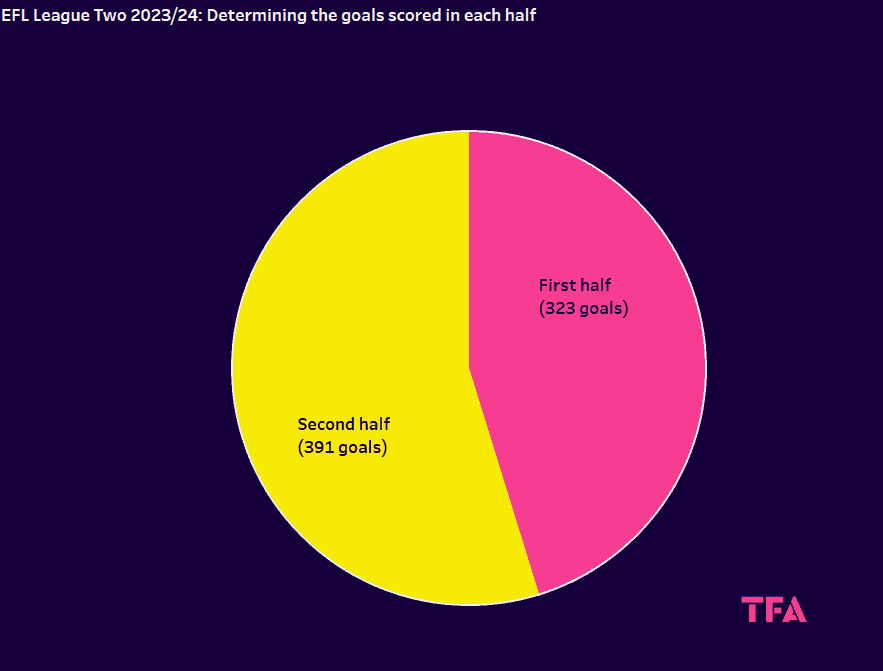
The pie chart shows that 54.8% of all League Two goals have been scored in the second half of matches, compared to 45.2% in the first half. This coincides with the fact that most teams matches features more goals in the last 15 minutes.

The table shows that 16 of the 24 League Two sides have been involved in matches where the majority of the total goals have been in the later stages. Considering the amount of stoppage time that has been added on in matches this season, though, this is unsurprising.
By further delving into the late goals in the final 15 minutes, we can see which sides are scoring the most…
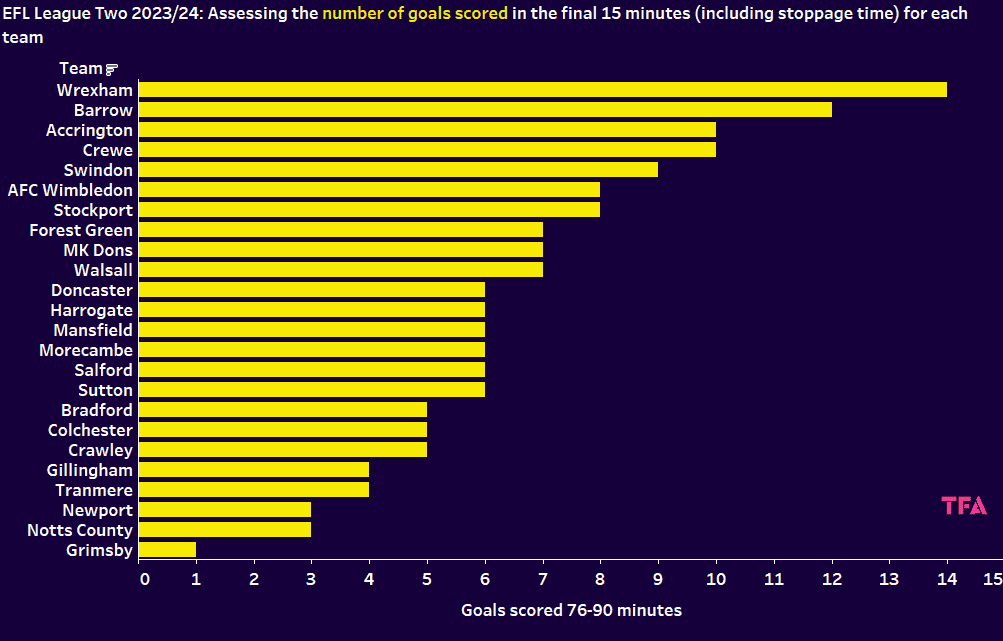
…and which sides are conceding the most in this period.
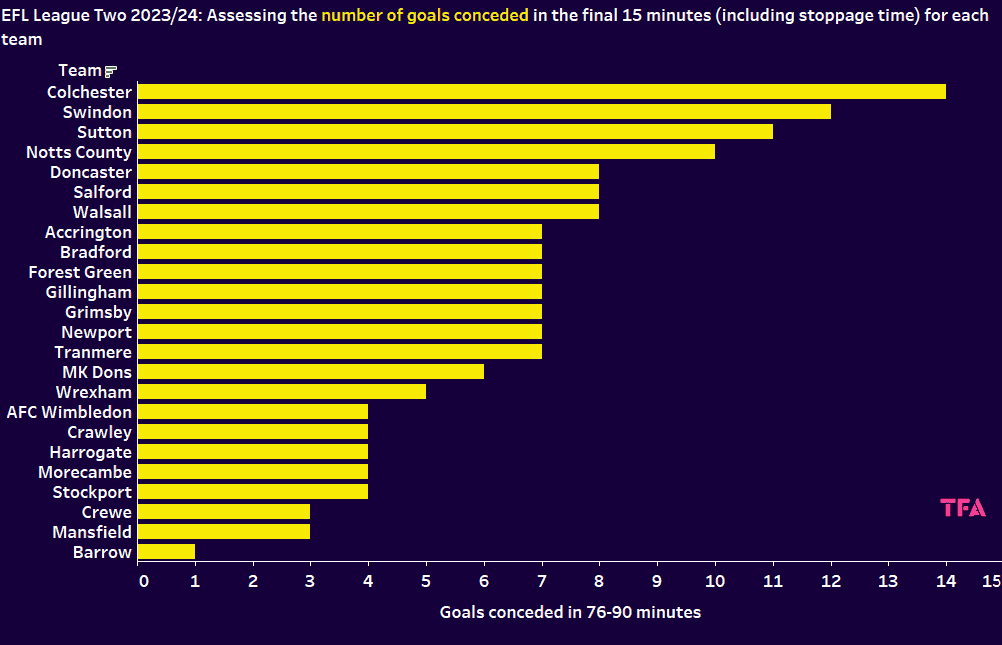
The bar chart shows that Colchester has conceded the most goals in the division in the later stages of matches. The Oysters have dropped 19 points from winning positions this season. Those extra 19 points would have put Colchester on 39 points. This tally would see them second in the league rather than 21st, where they currently lie, struggling at the wrong end of the table.
A look at the bar chart of goals scored in the final 15 minutes shows that the five teams who have scored the most in this period are in the top nine teams of the division. So does scoring late goals correlate with league position?
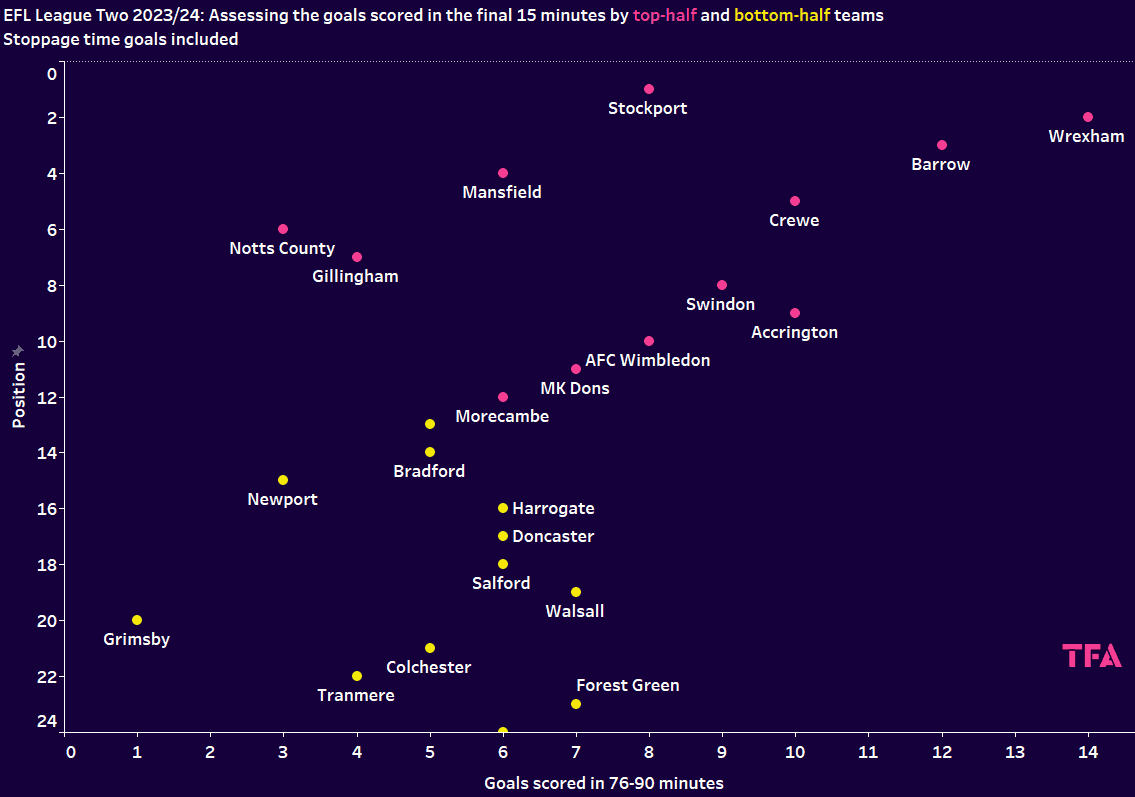
The scatter plot suggests that the teams scoring more goals in the final stages of matches are positioned higher up the league. We have looked at the correlation coefficient to assess this relationship.
The coefficient value is between -1 and +1, such that a value closer to -1 suggests a negative correlation, and a value closer to +1 suggests a positive relationship. In this analysis, the value is -0.5346155. This suggests a moderate negative correlation, such that those teams higher up the league (and thus have lower numerical position value) score more goals during this period.
The coefficient value is not particularly strong, though, if you factor in anomalies such as Notts County, who are sixth in the league but have only scored three goals in the final 15 minutes.
Similarly, we can assess the relationship between goals conceded in the final 15 minutes with league position.
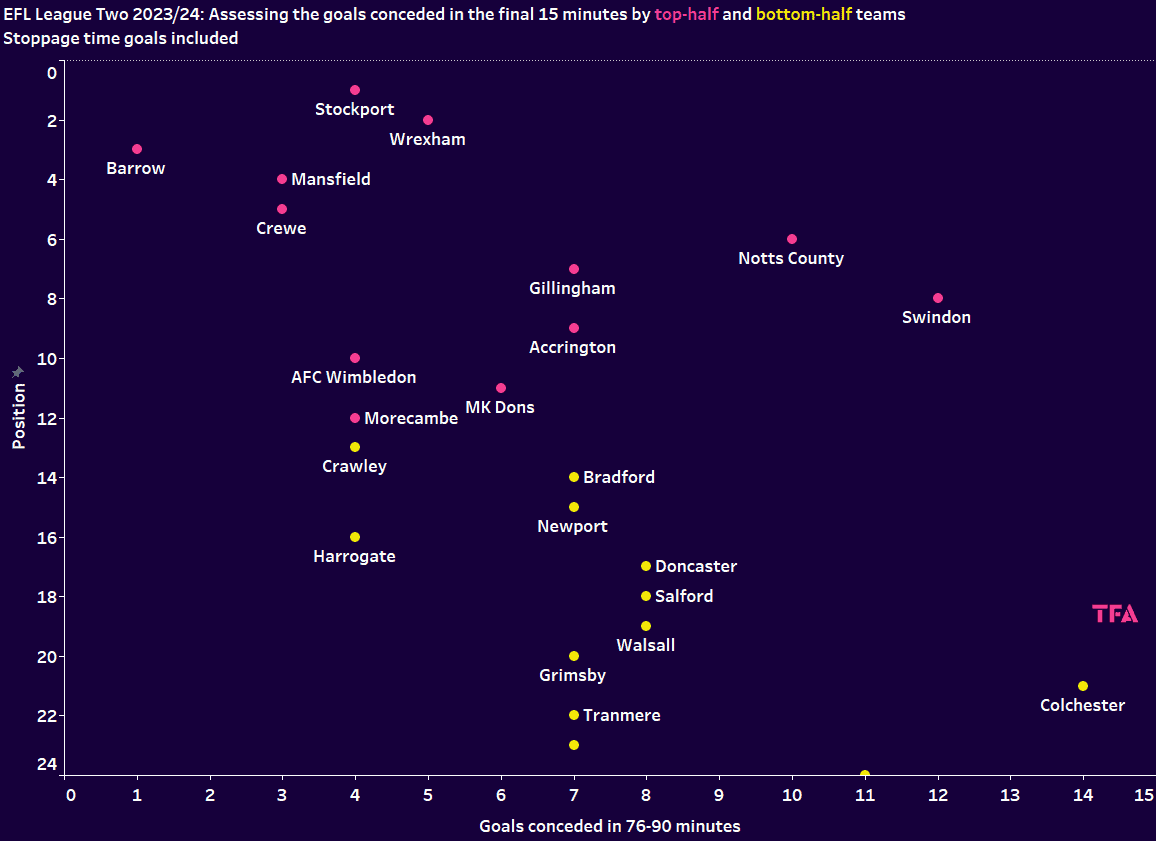
A similar trend is apparent such that those clubs at the lower end of the table tend to concede more in the final moments of matches. The coefficient value is 0.5118374. The coefficient value indicates a moderate positive correlation such that the higher the league position, the fewer goals conceded during this period.
Similarly to the goals scored analysis during this time, Notts County seem an outlier. They are positioned in the playoff places but have conceded 10 goals late on. Only three teams have conceded more during this period, including Swindon, who are also a top-half side. Swindon, hence, are seemingly an outlier too.
The analysis suggests a greater resilience for those teams higher up the league. For example, Barrow have come back to gain 10 points in the final 15 minutes of games. Without those 10 points, they would lie outside the playoffs rather than the automatic positions where they currently find themselves. This exemplifies the fine margins in football.
Moreover, Pete Wild’s side ranks joint second in the division for gaining points from a losing position, having accumulated 11 points in total. Without these 11 points, Barrow would lie 14th in the table, as not much separates the middle contingent in League Two.
The comeback kings of the league so far this season are Crewe, who have gained 16 points from losing positions. This is double the amount of Stockport, MK Dons, Salford, and Walsall, who rank joint sixth for comeback points from a losing position.
Without these 16 points, Crewe would only have 20 points, the same as Grimsby and Colchester, who are both hovering near the drop zone. At the other end of the comeback scale sit Gillingham and Doncaster. Neither side has gained a single point from a losing position this season. This implies that if a team can take the lead against either side, chances are they will go on to win.
Motivational talks at Swindon and Crewe
Swindon and Crewe have scored the most goals immediately after half-time, perhaps indicating half-time team talks as motivating for these two sides.

Both sides have scored nine goals within the first 15 minutes of the restart. Of the matches where Crewe scored in the opening 15 minutes of the second half, they were losing 75% at half-time. In each of those games, they went on to get something from the match following the early second-half fightbacks, winning two and drawing four times.
In addition, in the match against Newport, where Crewe scored early in the second half, the Railwaymen had gone into half-time at one all but eventually won the game 4-2. They scored three goals in 14 minutes. The first of these three came in the 57th minute.
In contrast, when Swindon have scored in the opening 15 minutes of the second half in the league this season, they had already been leading in 43% of these matches at the break. The Robins have not been able to come back in the same vein as Crewe, having only won once in these matches when losing at half-time.
Interestingly, one player who has seemingly benefited from the half-time team talk for Swindon has been their striker, Jake Young. Young scored five in the second half’s opening exchanges, representing 55.6% of Swindon’s goals during this period.
Young is the division’s top scorer with 16 goals so far, and although he has taken the headlines this season, Swindon as a team are one of the best performing in the league, topping the goalscoring charts with 43 goals.
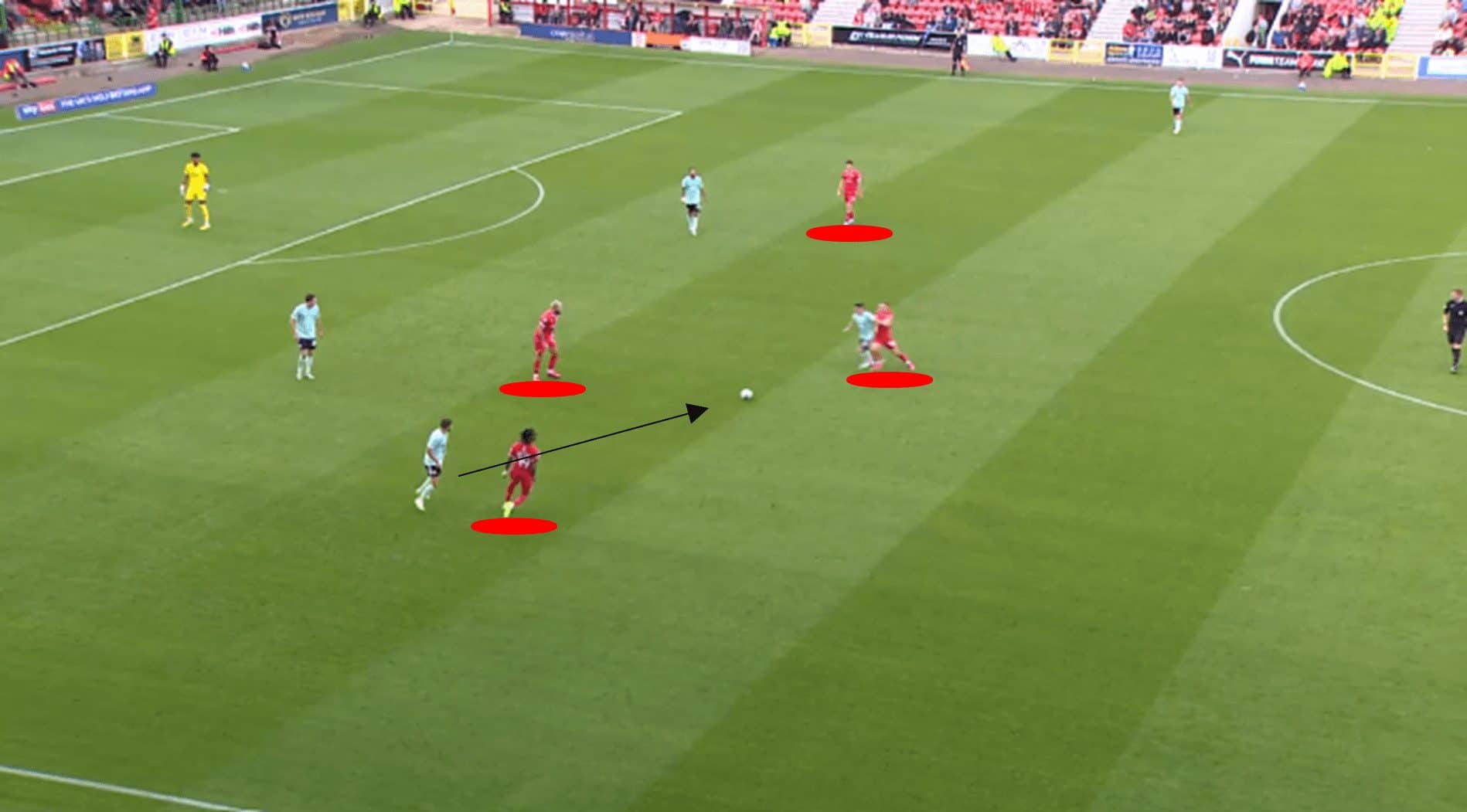
Against Crawley at the County Ground, Swindon took a one-nil lead into the break and adopted a high press in the early stages of the second half.
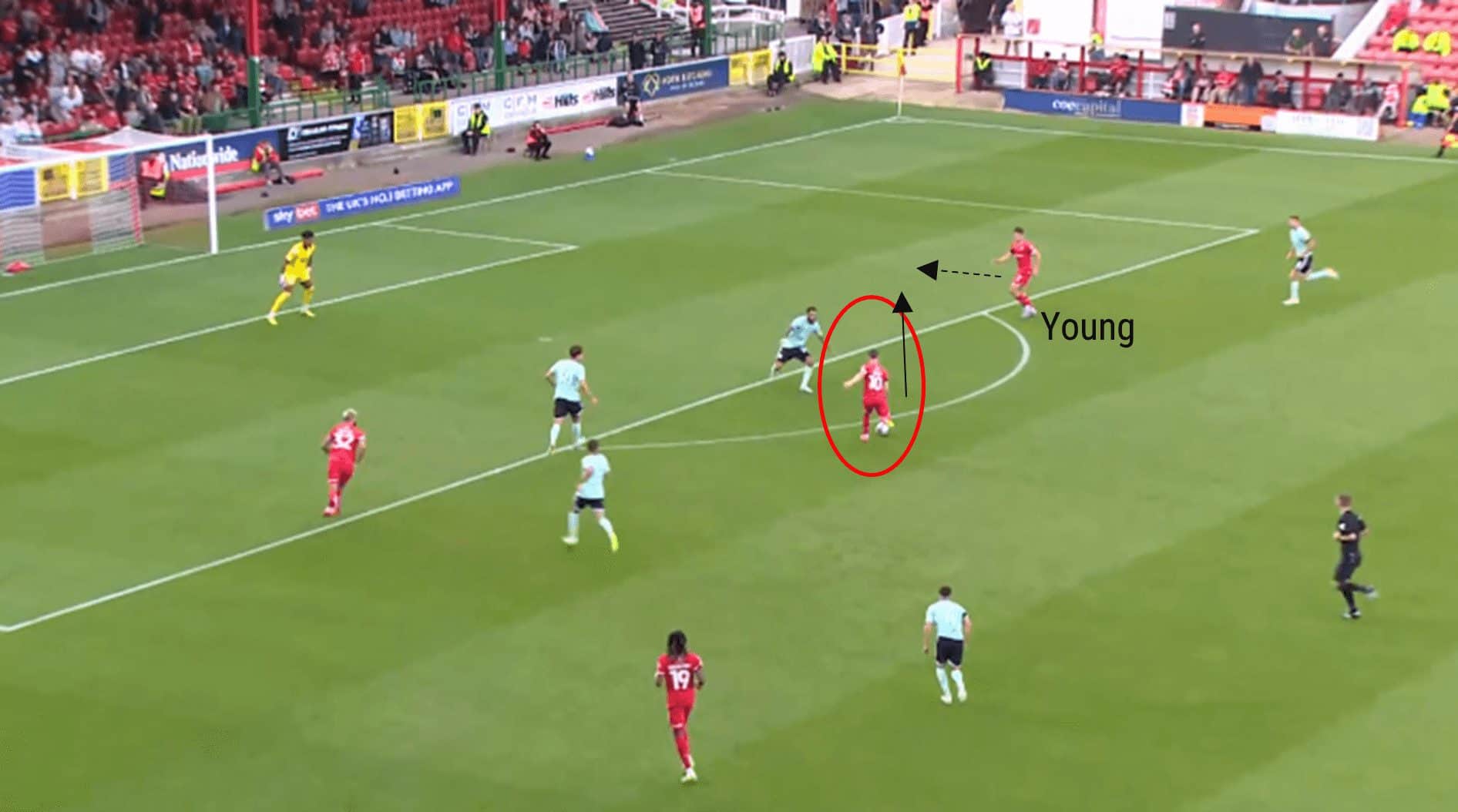
Upon winning the ball, titis passed into the path of Young, who extends Swindon’s lead. When Swindon have scored in the early stages after half-time, they look to extend their lead, such as in the example above. It’s a rewarding philosophy at present, considering they are just outside the playoff places.
Conclusion
In this data analysis, we have determined that most goals in League Two occur in the last 15 minutes of matches; the fewest amount of goals occur in the opening 15 minutes. We have seen there is an upward trend in goals as matches progress.
This analysis has further identified periods of the games where certain teams are particularly weak or strong. While MK Dons tend to record results, having started games strong, Colchester has dropped a lot of precious points from leaking goals late on. In contrast, Barrow has benefitted in the latter stages of games, and such late goals have propelled them into the automatic promotion places.
We have shown in this analysis that Stockport know how to pile on the pressure, Crewe are the comeback kings and Swindon’s Young has been particularly lethal in the opening stages of the second half of games. The data has further suggested a relationship between those higher up the division and scoring late goals; those lower down the division tend to concede more late goals.
It is such a resilient nature that could suggest what separates those gunning from promotion and those struggling at the wrong end. This analysis has shown that League Two fans shouldn’t be leaving matches early. Chances are that if they do, they will miss some goals.






Comments